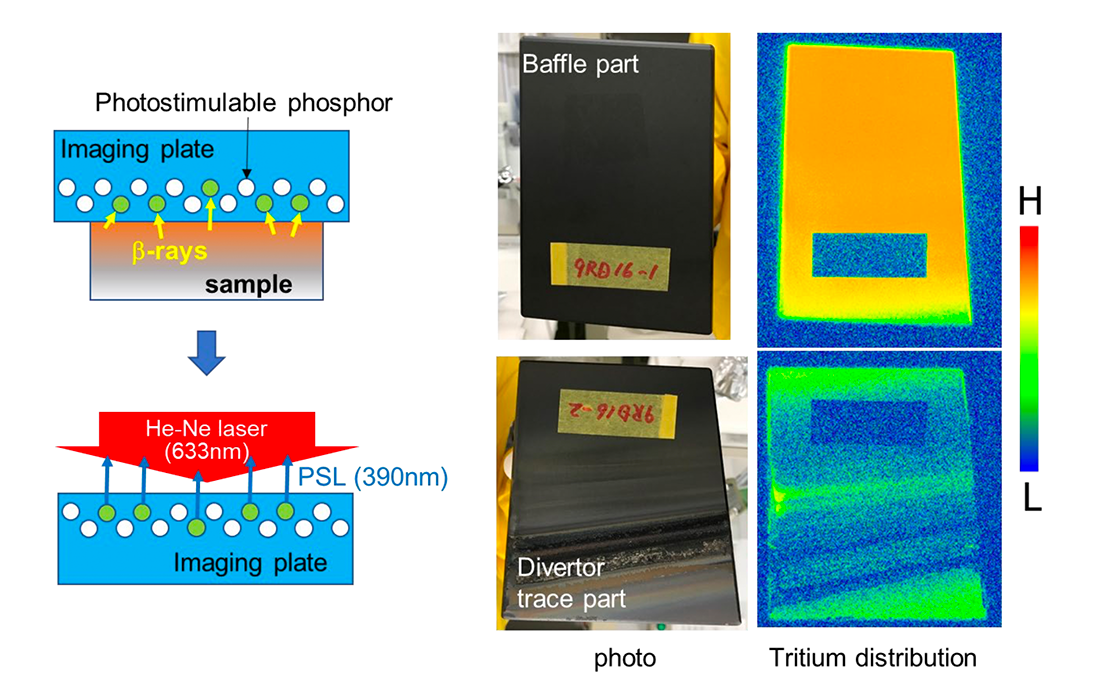First observation of tritium distribution on plasma facing surfaces in stellarator/heliotron devices
In LHD, tritium distribution on plasma facing surfaces was investigated for the first time in stellarator/heliotron devices by using the tritium imaging plate technique after the first deuterium plasma experimental campaign. In-vessel components such as divertor tiles and first wall panels and long-term material probes retrieved from the vacuum vessel were analyzed. It was revealed that tritium remained most densely in the baffle part of inner divertor tiles made of graphite.

Right figure: Photos of set of divertor tiles located at around mid-plane in inboard-side divertor (9-I), and tritium distribution on tiles obtained by tritium imaging plate technique.
Tritium distribution on plasma facing surfaces after the first deuterium plasma experimental campaign, conducted over four months, was investigated in the Large Helical Device (LHD) for the first time in stellarator/heliotron devices by using the tritium imaging plate technique. In-vessel components such as divertor tiles and first wall panels, and long-term material probes retrieved from the vacuum vessel were analyzed. The in-vessel component in which tritium remained most densely was the baffle part of divertor tiles, made of graphite retrieved from the inboard-side divertor. Asymmetric tritium retention was observed on divertor tiles located at magnetically symmetric positions, and could be attributed to the toroidal field direction dependence of the asymmetric loss of energetic tritons generated by deuterium–deuterium nuclear fusion reactions. On the first wall, tritium remained in a deposited layer, which mainly consisted of carbon.
In the LHD, the first deuterium plasma experimental campaign was conducted in 2017 for four months. During the campaign, tritons were generated by deuterium-deuterium fusion reactions. It is very important to analyze the remaining tritium in the vacuum vessel from the viewpoints of safety, plasma-wall interaction and energetic particle transport.
During and after the first D plasma campaign, a dedicated investigation of tritium behavior was conducted. Because there was no tritium in the LHD before the campaign, this was a good opportunity to reveal tritium behaviors in the LHD. The neutron measurements and evacuated gas analyses revealed that the total amount of generated tritium was 6.5 GBq during the first D experimental campaign. Approximately 35.5 % of the generated tritium amount was exhausted by pumps during the campaign. Approximately 60 % of the generated tritium still remained in the vacuum vessel before the start of the experimental campaign in 2018.
The LHD research group, in collaboration with researchers at Kindai University, Shizuoka University, Kyushu University, Hokkaido University and Wuhan University of Technology in China, worked to investigate the remaining tritium on plasma facing surfaces. Tritium retention in divertor tiles made of graphite, the first wall panels made of Type 316L stainless steel (SUS316L) and SUS316L material probes located on the first wall were analyzed by using the tritium imaging plate technique (TIPT).
Tritium remains densely on divertor tiles, especially the baffle parts on the inboard-side divertor which are not irradiated by divertor plasma in the standard magnetic configuration. On other tiles, amounts of remaining tritium within the TIPT detection depth are much less than for baffle parts. This can be attributed to the divertor plasma irradiation. The asymmetric distribution of retained tritium in divertor tiles at magnetically symmetric positions reflects the distribution of loss points of promptly lost tritons on the vacuum vessel, which was calculated by using a Lorentz orbit following code (LORBIT).
On the first wall, tritium mainly remains in a carbon dominant deposition layer. At deposition dominant positions, the areal density of remaining tritium is similar to divertor tiles except baffle parts. At erosion dominant positions, the remaining tritium within the TIPT detection depth is more than one order of magnitude smaller than at deposition dominant positions.
To conclude, the remaining tritium distribution in the LHD vacuum vessel, a total retention measurement such as thermal desorption spectroscopy or even depth profiles of remaining tritium in the plasma facing components are necessary, because the TIPT can measure a tritium amount less than 1 μm in depth in the case of graphite, which is shallower than the penetration depth of 1.01 MeV triton in graphite. For a more detailed comparison between the remaining tritium distribution and the calculated distribution of loss positions of triton on plasma facing surfaces, a calculation which takes into account the in-vessel components is necessary. These works are ongoing and will be described elsewhere.
This research result was published in Physica Scripta, an international journal on physics and physical sciences, in 2020.
